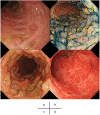Current Diagnostic and Therapeutic Approaches to Cytomegalovirus Infections in Ulcerative Colitis Patients Based on Clinical and Basic Research Data
- PMID: 32244555
- PMCID: PMC7177554
- DOI: 10.3390/ijms21072438
Current Diagnostic and Therapeutic Approaches to Cytomegalovirus Infections in Ulcerative Colitis Patients Based on Clinical and Basic Research Data
Abstract
Human cytomegalovirus (HCMV) is a ubiquitous herpesvirus (the human herpesvirus 5) and an opportunistic pathogen that primarily infects HIV-positive and other immuno-compromised patients. Retrospective studies in the field of inflammatory bowel disease (IBD) have suggested a relationship between a concomitant colonic HCMV infection and poor outcomes in patients with an ulcerative colitis (UC) due to the presence of HCMV in surgical specimens of patients with a toxic megacolon or a steroid-resistant UC. Therefore, gastroenterologists have focused on the contribution of HCMV infections in the exacerbation of UC. Numerous studies have addressed the benefits of treating colonic HCMV reactivation in UC using an antiviral treatment. However, its clinical relevance remains uncertain as only a few prospective studies have assessed the direct relationship between clinical outcomes and the viral load of HCMV in colonic tissues. HCMV reactivation can be triggered by inflammation according to fundamental research studies. Thus, optimal control of intestinal inflammation is essential for preventing an HCMV reactivation in the intestinal mucosa. Indeed, several reports have indicated the effectiveness of an anti-tumor necrosis factor-alpha (TNFα) treatment in patients with an active UC and concomitant HCMV infections. In this review, we describe the mechanism of HCMV reactivation in UC cases and discuss the current issues regarding diagnosis and treatment of HCMV infections in UC patients.
Keywords: HCMV colitis; human cytomegalovirus; inflammatory bowel disease; ulcerative colitis.
Conflict of interest statement
The authors declare no conflict of interest.
Figures



Similar articles
-
Human cytomegalovirus and Epstein-Barr virus infection in inflammatory bowel disease: need for mucosal viral load measurement.World J Gastroenterol. 2015 Feb 14;21(6):1915-26. doi: 10.3748/wjg.v21.i6.1915. World J Gastroenterol. 2015. PMID: 25684960 Free PMC article.
-
Establishment of a novel mouse model of ulcerative colitis with concomitant cytomegalovirus infection: in vivo identification of cytomegalovirus persistent infected cells.Inflamm Bowel Dis. 2013 Aug;19(9):1951-63. doi: 10.1097/MIB.0b013e318293c5bf. Inflamm Bowel Dis. 2013. PMID: 23839229
-
Diagnosis and treatment of ulcerative colitis with cytomegalovirus infection: importance of controlling mucosal inflammation to prevent cytomegalovirus reactivation.Intest Res. 2014 Jan;12(1):5-11. doi: 10.5217/ir.2014.12.1.5. Epub 2014 Jan 28. Intest Res. 2014. PMID: 25349558 Free PMC article. Review.
-
The association between antigenemia, histology with immunohistochemistry, and mucosal PCR in the diagnosis of ulcerative colitis with concomitant human cytomegalovirus infection.J Gastroenterol. 2023 Jan;58(1):44-52. doi: 10.1007/s00535-022-01931-2. Epub 2022 Oct 26. J Gastroenterol. 2023. PMID: 36287269 Free PMC article.
-
Cytomegalovirus and ulcerative colitis: Place of antiviral therapy.World J Gastroenterol. 2016 Feb 14;22(6):2030-45. doi: 10.3748/wjg.v22.i6.2030. World J Gastroenterol. 2016. PMID: 26877608 Free PMC article. Review.
Cited by
-
A Rare Case of Herpes Simplex Virus and Cytomegalovirus Dual Infection Inducing Unremitting Ulcerative Colitis.Cureus. 2023 Sep 13;15(9):e45166. doi: 10.7759/cureus.45166. eCollection 2023 Sep. Cureus. 2023. PMID: 37842466 Free PMC article.
-
Human Cytomegalovirus Infection of Epithelial Cells Increases SARS-CoV-2 Superinfection by Upregulating the ACE2 Receptor.J Infect Dis. 2023 Feb 14;227(4):543-553. doi: 10.1093/infdis/jiac452. J Infect Dis. 2023. PMID: 36408607 Free PMC article.
-
Human Cytomegalovirus and Autoimmune Diseases: Where Are We?Viruses. 2021 Feb 8;13(2):260. doi: 10.3390/v13020260. Viruses. 2021. PMID: 33567734 Free PMC article. Review.
-
Cytomegalovirus Infection in Adult Patients with Inflammatory Bowel Disease: A Literature Review.Arch Iran Med. 2024 May 1;27(5):277-286. doi: 10.34172/aim.2024.40. Arch Iran Med. 2024. PMID: 38690795 Free PMC article. Review.
-
Characteristics and Clinical Implications of Cytomegalovirus Infection in Patients with Drug-Resistant Ulcerative Colitis Undergoing Colectomy-Data from a Tertiary Referral Center in Poland.J Clin Med. 2025 Jul 8;14(14):4823. doi: 10.3390/jcm14144823. J Clin Med. 2025. PMID: 40725516 Free PMC article.
References
Publication types
MeSH terms
Substances
LinkOut - more resources
Full Text Sources
Medical

